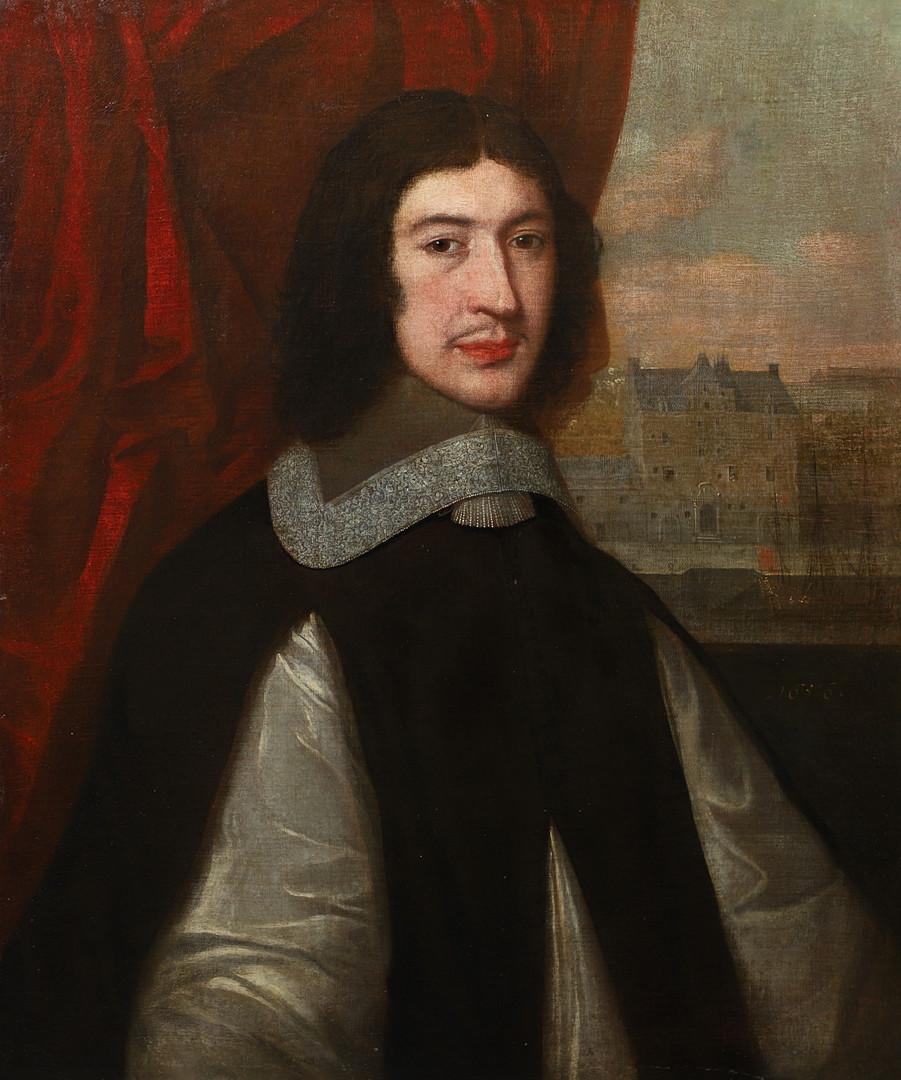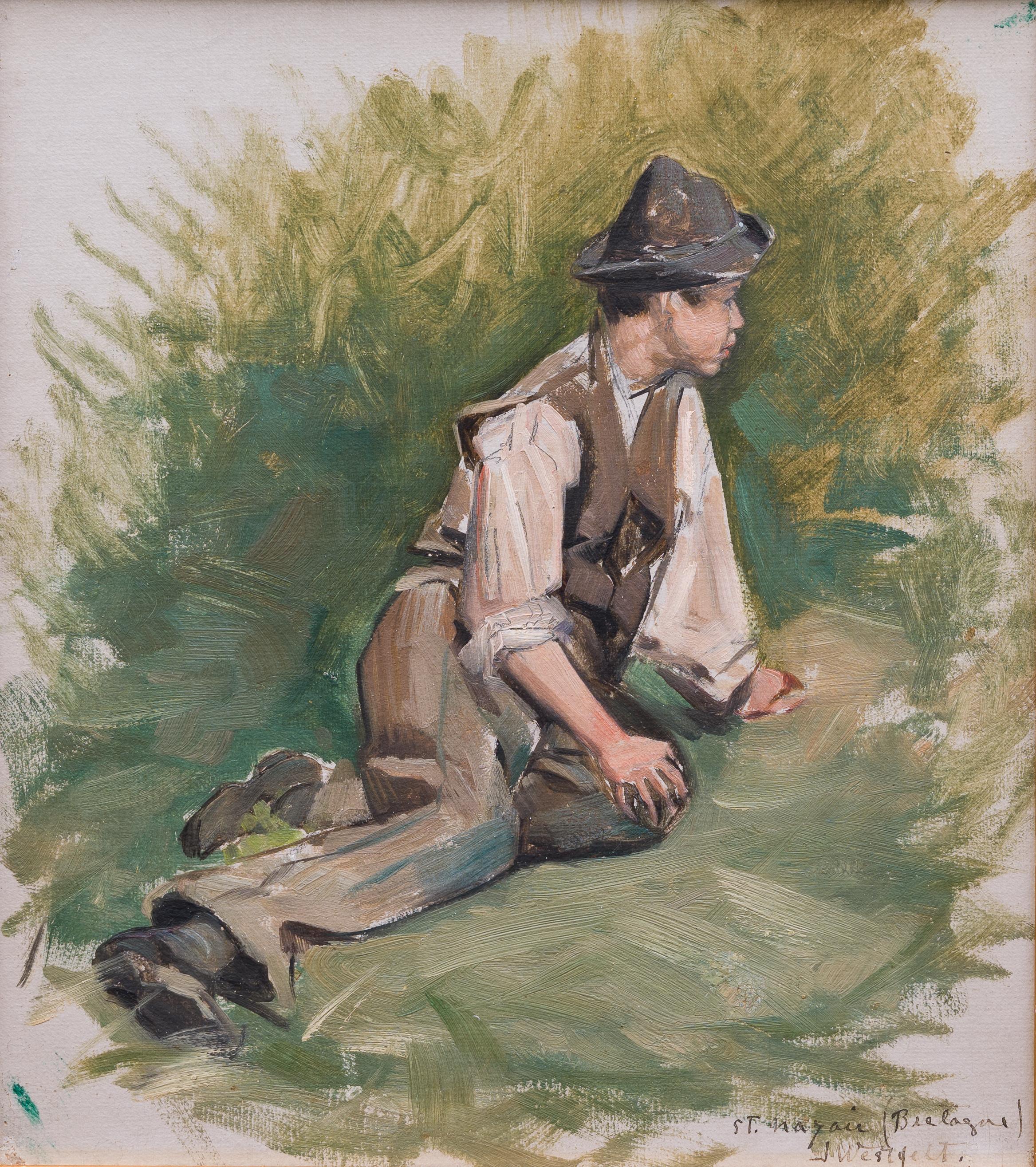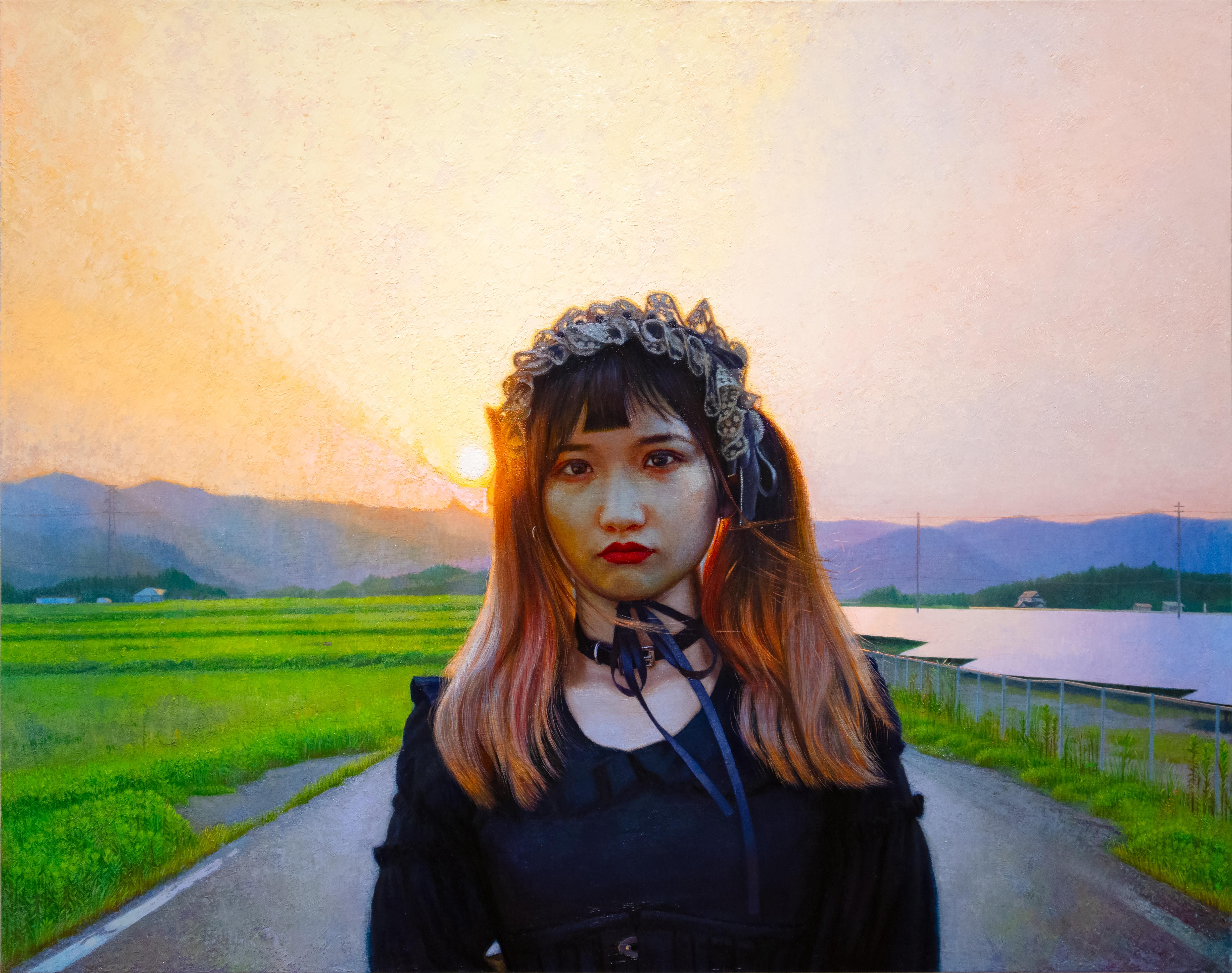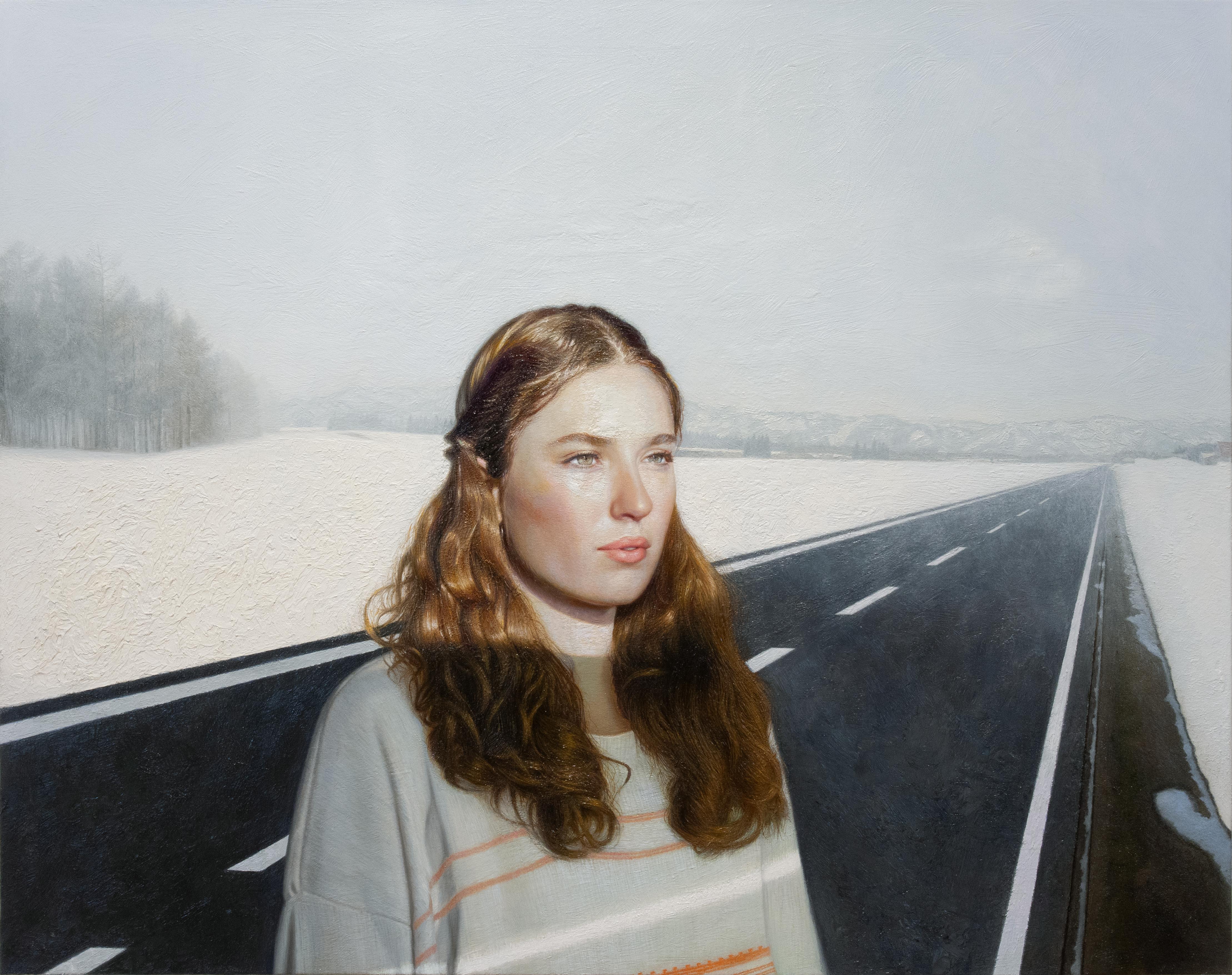Items Similar to Attributed to John Riley, 17th century English portrait of a girl on a terrace
Want more images or videos?
Request additional images or videos from the seller
1 of 7
Attributed to John Riley, 17th century English portrait of a girl on a terracec. 1685
c. 1685
About the Item
Portrait of a young girl, full-length, wearing a blue silk gown, standing on a terrace beside a classical urn holding a branch with blossom. Attributed to John Riley (1646-1691). Oil on canvas, in a period cassetta giltwood frame. c.1685.
The sensitively painted young girl's face has a softness and realism conveying a sense of her character which is typical of Riley's artistic style, rather than the usual idealised depiction of beauty in this period. The white blossom she holds is possibly orange blossom which was often used to symbolise the purity and youth of the sitter and her availability for marriage.
Dimensions in frame 186 x 126cm
Provenance:
Private collection, Vienna
Christie's sale, London 20 February 1920, lot 136, sold as part of the estate of Arthur van de Vahl of Lancaster Gate, London, purchased by Gooden and Fox for £52 and 10 shillings.
John Riley (1646-1691) was born in Bishopsgate, London and was the son of John Riley Senior and his stepmother Jochebed (d. Jan 1693). In around 1660 Riley began training under Isaac Fuller (1606-1672) and later under Gerard Soest (1605-1681). The courtier and Keeper of the King's Jewels and Closet, Thomas Chiffinch sat for him, and was so pleased with his portrait (Dulwich Picture Gallery) that he showed it to King Charles II. Charles II gave Riley some commissions, eventually sitting for him himself where he commented 'Is this like me? then odds fish I'm an ugly fellow!'. Riley allegedly took this comment personally and he was never able to bear looking at the portrait again.
His friend and earliest biographer, Richard Graham claimed 'that which eminently distinguished [Riley] from all his contemporaries was his peculiar excellence in a Head and especially the colouring part'. Riley realised where his strengths and weaknesses lay and hired fellow artists such as Baptiste Gaspars (1641-1692), who had also worked with Lely to paint 'postures'. (in 1681 the Painter Stainers' Company asked Riley and Gaspars to paint a portrait of the Duchess of York for them). Riley also worked in partnership with John Closterman who was particularly skilled in painting clothes or 'draperies' and who finished several of Riley`s portraits after his death. The three quarter length of Katherine Elliott (d.1688) in the Royal Collection is described in a Queen Anne inventory as 'Ryley ye Head Closterman ye drapery' (Millar, no. 331).
According to Riley's pupil Thomas Murray (1663-1735), Riley refused to even allow his students to watch him while he was painting 'from life'. This contrasted with his rival Kneller in the 1680's who was incredibly confident and allowed anyone to watch him at close quarters while he worked. Graham claimed that one of the reasons Riley was so successful as a portrait painter was because 'he was a gentleman extremely courteous in his behaviour, obliging in his conversation, never guilty of a piece of vanity of saying mighty things on his own behalf and was prudent in his actions'. Thomas Murray's account corroborates this, showing how Riley could 'hide his feelings and be agreeable'. Riley was a quiet, modest man and appears to have been more comfortable occupying himself with less illustrious sitters from the professional classes and more unusually from the lower serving classes - with one of his most famous portraits being a grand society full length portrait of serving lady Bridget Holmes (Royal Collection). Riley is known for his gentleness and sensitivity of approach in depicting the characters of his sitters, giving an air of engaging modesty about them, such as seen in his portrait of the playwright Aphra Benn. This sobriety of manner was an aspect of his style which he passed on to his pupil Jonathan Richardson (1667-1745) which in turn went on to influence the painting of his pupil Thomas Hudson and then his pupil Joshua Reynolds.
Riley's career culminated in July 1689 when he was appointed joint Principal Painter to William III and Queen Mary with Godfrey Kneller. Richardson is said to have married Riley`s niece who then administered his will on Riley's death in 1691, selling Riley's art collection in 1693.
Literature:
Sir Roy Strong 'The British Portrait'. Introduction 'The British Obsession' p.61.1991.
Richard Charlton-Jones 'The British Portrait' Chapter 1.1991.
J. Douglas Stewart, ' Riley, John (1646-1691)'. Oxford Dictionary of National Biography. Oxford University Press, 2004.
'RILEY, John', Benezit Dictionary of Artists, Oxford Art Online 2014.
- Attributed to:John Riley (1646 - 1691, English)
- Creation Year:c. 1685
- Dimensions:Height: 73.23 in (186 cm)Width: 49.61 in (126 cm)
- Medium:
- Movement & Style:
- Period:
- Condition:
- Gallery Location:Bath, GB
- Reference Number:1stDibs: LU9527560772
About the Seller
5.0
Vetted Seller
These experienced sellers undergo a comprehensive evaluation by our team of in-house experts.
Established in 2002
1stDibs seller since 2015
37 sales on 1stDibs
Typical response time: 1 hour
Associations
The British Antique Dealers' AssociationLAPADA - The Association of Arts & Antiques DealersInternational Confederation of Art and Antique Dealers' Associations
- ShippingRetrieving quote...Ships From: Bath, United Kingdom
- Return PolicyA return for this item may be initiated within 3 days of delivery.
More From This SellerView All
- An English 18th century portrait of James Stanley, standing in a landscapeBy John Hamilton MortimerLocated in Bath, SomersetPortrait of James Stanley (1750 - 1810), circa 1775-1778, full-length, wearing a red coat and breeches and a gold embroidered waistcoat, hold...Category
1770s English School Portrait Paintings
MaterialsOil, Canvas, ABS
- A portrait of a lady and her daughter with an exotic birdBy Michael DahlLocated in Bath, SomersetA portrait of a lady three-quarter length, seated in an interior, wearing a red silk gown draped in a pink silk sash with an exotic bird perched on her hand and one arm resting on a stone plinth, her young daughter wearing a green silk gown standing at her side. Oil on canvas, housed in a period 'Lely' giltwood frame. This double portrait was painted at the height of Dahl's career in circa 1715 when Dahl had become firmly established as one of the leading portrait painters in Britain. Although the identities of the sitters are currently unknown, it is a sensitive depiction of a close and affectionate bond between a mother and daughter, with the young girl's hand resting affectionately on her mothers lap. The tamed exotic bird adds a charming decorative element which also serves to convey the high social status of the lady, given only the very wealthy would be able to own such a rare and expensive pet and the lively colouring of the bird's feathers is reflected in the colours of the sitters' silk gowns. Provenance: Private collection, London Michael Dahl (Stockholm 1659-1743 London) was born in Stockholm in Sweden and studied under Martin Hannibal (d 1741) and later with David Klöcker Ehrenstrahl. In 1682 he travelled to London, where he became acquainted with Godfrey Kneller and Henry Tilson, and in 1685 he left for Europe with Tilson, working briefly in Paris before continuing to Venice and Rome, where they stayed for about two years. In Rome Dahl converted to Roman Catholicism and gravitated towards the circle of Christina, former Queen of Sweden, who sat for him (Grimsthorpe Castle, Lincs). He returned to England with Tilson via Frankfurt and arrived in London in 1689, staying in England for the remainder of his career. During Dahl's absence, Kneller had consolidated his supremacy in London as the most fashionable portrait painter, but Dahl rapidly became Kneller’s closest competitor. His patrons probably had roots in the Swedish diplomatic circles, but it expanded as a result of his ability and his agreeable personality. His prices were lower than those of Kneller and he favoured softer, more diffused, colour tones and could respond to his sitters with sincerity and humanity. Politically, Kneller supported the ascendant Whigs while Dahl was a Tory, but they frequently painted the same sitters from both parties, and in spite of fundamental differences in technique and temperament, their work was sometimes similar in appearance. Dahl was prolific but rarely signed his work, and comparatively few of his portraits were engraved in mezzotint, the method used by Kneller to widen his reputation. By 1690 he had painted the aged Duke of Schomberg (engraved by William Faithorne) and Prince George of Denmark (London, Kensington Palace). He was ignored by William III but received commissions from Princess Anne, including one for a portrait of herself (Oakly Park, Ludlow, Salop). He also painted the future Duke and Duchess of Marlborough, and his informal portrait of the Duchess (Althorp House, Northants), formerly attributed to Kneller, is perhaps the most intimate of all images of her. During the 1690s he secured the patronage of Charles Seymour, the ‘Proud’ 6th Duke of Somerset, who ordered a series of seven full-length portraits of notable contemporary beauties from Dahl (1690s; Petworth House, W. Sussex, NT). This was originally a scheme similar to Kneller’s more famous ‘Hampton Court Beauties’, but the portraits were subsequently reduced to three-quarter-length formats. The features of the sitters are not individualized, but they possess a decorative, languorous glamour that recalls Lely rather than Kneller. Somerset gave Dahl further employment over the next 25 years. In 1698, following the death of Klöcker Ehrenstrahl, Dahl was offered the post of court painter at Stockholm, which he apparently refused, preferring to remain in London at his studio in Leicester Fields, near the Swedish legation. In about 1700 he was joined by a young compatriot, Hans Hysing, who worked with him for many years. Dahl seems not to have married until after 1708, He had a son Michael (d. 1741), also a painter, of whose work nothing is known, and two daughters. After the accession of Queen Anne in 1701, she and Prince George sat for a number of official portraits. His royal patronage ceased with Queen Anne’s death, and when Dahl refused to paint the infant Duke of Cumberland in 1722. He was suspected of Jacobite sympathies, and relations had cooled between him and the Swedish legation. However, his practice continued to prosper, and he acquired another important patron in Edward Harley, 2nd Earl of Oxford, who shared his political views and whose circle included the architect James Gibbs and the poets Matthew Prior and Alexander Pope, all of whom Dahl painted. Oxford commissioned several portraits of himself. In the earliest (1719; Welbeck Abbey...Category
Early 18th Century Old Masters Portrait Paintings
MaterialsCanvas, Oil
- 17th century Dutch portrait of a Lady in Red adorned with PearlsBy Pieter NasonLocated in Bath, SomersetPortrait of a lady, half-length in a feigned oval wearing a ruby coloured silk gown holding entwined strings of pearls across her bodice. Signed 'PNason' and dated 1667 (lower right)...Category
17th Century Old Masters Portrait Paintings
MaterialsOil, Canvas
- 17th century portrait of a ladyBy Nicolaes MaesLocated in Bath, SomersetPortrait of a lady richly dressed in a purple silk gown with white sleeves, a gold coloured cloak draped across one shoulder, her blonde curls worn up...Category
17th Century Old Masters Portrait Paintings
MaterialsCanvas, Oil
- 17th century portrait of lady in an ivory silk gown and lace collarBy Cornelius JohnsonLocated in Bath, SomersetCircle of Cornelius Johnson (1593-1661), a 17th century portrait of a lady, bust-length oval, wearing an ivory silk gown with blue silk bows and lace c...Category
Early 17th Century Old Masters Portrait Paintings
MaterialsOil, Canvas
- 18th century painting of the Dalbiac family in the gardens of a country houseBy Charles PhilipsLocated in Bath, SomersetThe painting depicts James (Jacques) Dalbiac, his wife Louise (ne de la Porte) and their five children, James, Charles, Louise, Marianne and Martha in the ornamental gardens of a grand country estate. The extensive gardens extend into the distance with gardeners working in the background and figures strolling through the avenues of trees. A peacock and peahen can be seen on the wall to the left and a potted orange tree to the right. Louise Dalbiac holds an orange taken from the orange tree, aluding to the family's faith and their loyalty to the protestant King William of Orange and their adopted country. The Dalbiacs were wealthy London silk and velvet merchants of French Huguenot origin who had fled France at the end of the 17th century to escape persecution for their protestant faith. England offered safe refuge and their skills and industriousness allowed them to establish one of the most successful businesses in London's Spitalfields which became a new centre of the silk trade, effectively leading to the collapse of the once dominant French silk industry. Both sons, James and Charles followed their father and Uncle into the family business, successfully growing the family's fortune and each going on to own their own country estates. A conversation piece is a genre of painting used to describe group portraits of families and friends, often depicted with their servants and family pets and set within an elegantly furnished interior or the garden of a grand country house. They were a celebration of the intimacy of family relations as well as a sign of status, property and the power of succession. The informality of conversation pieces grew popular in 18th century England, allowing the sitters to present themselves in a more relaxed pose, perhaps engaged in intellectual conversation or showing their talents or interests. In this present portrait, the Dalbiacs are shown richly dressed and and at leisure in a grand country house setting, conveying their success and cultural and social aspirations. Charles Philips (c.1703–1747) was an English artist known for painting a number of portraits and conversation pieces for noble and Royal patrons in the mid-eighteenth century. He was the son of portrait painter Richard Philips...Category
Early 18th Century Old Masters Portrait Paintings
MaterialsCanvas, Oil
You May Also Like
- Mid 17th Century British Old Master Oil Painting Portrait of Man in Flemish CityLocated in Cirencester, GloucestershirePortrait of Thomas Collard (rector of Withycombe, Somerset 1670-1691) the city depicted in the distance is thought to be Antwerp. the portrait historically has been thought to be fr...Category
Mid-17th Century Old Masters Portrait Paintings
MaterialsCanvas, Oil
- Lost in Thoughts, Oil Sketch Painted in Brittany (Bretagne), Before 1890Located in Stockholm, SEWe are delighted to offer a unique and evocative piece by the Swedish artist Ingeborg Westfelt-Eggertz. This small oil sketch captures a moment in time, portraying a young man seated...Category
1880s Landscape Paintings
MaterialsCanvas, Masonite, Oil
- Ralph Pallen Coleman (American 1892-1968) A Monumental Painting of Jesus ChristLocated in New York, NYRalph Pallen Coleman (American 1892-1968) A Monumental Painting of "The Resurrection of Jesus Christ", circa 1940. Measuring 102" high x 77" wide (framed), this massive oil on canvas painting is truly one of a kind. The quality throughout the entire painting is masterful. The painting is very realistically painted with bright, vibrant, colors which shows the artists true passion and love for Jesus and Christianity. Ralph Pallen Coleman was an American painter and illustrator. His career spanned more than half a century during which he illustrated stories for many magazines, and later, religious illustrations and paintings which provided images of Christianity to millions of people during the 1950s-1960's. A native of Philadelphia, Pennsylvania, he grew up and lived there throughout his 75 years. He received his formal art education at the Philadelphia School...Category
1940s Portrait Paintings
MaterialsOil, Canvas
- Howdi Do - by Marc Zimmerman - Figures Landscape ArtBy Marc ZimmermanLocated in Carmel, CAHowdi Do - by Marc Zimmerman - Figures Landscape Art This masterpiece is exhibited in the Zimmerman Gallery, Carmel CA. ABOUT THE ARTIST Marc Zimmerman is a visionary artist whose c...Category
2010s Contemporary Portrait Paintings
MaterialsCanvas, Oil
- No Man's LandLocated in Toronto, CADaisuke Takeya’s “No Man’s Land” is his 5th solo exhibition with the gallery, presenting a new series distinct from, and yet analogous to, the parts of ...Category
2010s Contemporary Portrait Paintings
MaterialsCanvas, Oil
- Snow CountryLocated in Toronto, CADaisuke Takeya’s “No Man’s Land” is his 5th solo exhibition with the gallery, presenting a new series distinct from, and yet analogous to, the parts of his practice that have been ex...Category
2010s Contemporary Portrait Paintings
MaterialsCanvas, Oil




